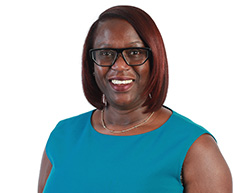As part of the Birmingham office's Growth Through Change series – a programme of content and events concentrated on helping businesses grasp opportunities and optimise for a changing landscape in the Midlands – we look at how all businesses should be embracing diversity and how this could stimulate growth.
As businesses grapple with a host of challenges, Yetunde Dania, partner and head of the Birmingham office at Trowers & Hamlins, believes that any response to change should embrace diversity, while employment partner Rebecca McGuirk shares why it is the role of leaders to champion the importance of diversity and inclusion right from the very top of the organisation.
Yetunde: Incorporating diversity and inclusion into the equation
To feel included and supported in the workplace, it's important for employees to see themselves represented across the organisation. Low-cost initiatives such as mentoring, shadowing, targeted training courses, sponsorship and positive action in recruitment can all help in the move towards a more diverse and inclusive environment.
The push for diversity and inclusion also involves ensuring that those from racialised communities can move into leadership roles. The West Midlands Combined Authority's (WMCA) Race Equalities Taskforce's 'Race Forward' independent strategy, published in March 2023, looks to reduce racial disparity across the core areas of which the WMCA has power and influence.
The strategy was created in response to a report published by the West Midlands Leadership Commission which found evidence of a "significant diversity gap at senior levels" and that although there has been a growing appetite for change, "the makeup of leadership across the West Midlands has not significantly changed".
The Leadership Commission set up a training scheme in 2021 to try to change this, offering potential candidates a chance to learn and develop the skills needed to successfully secure a position on a board or a committee of an organisation.
Race Forward shows that race inequality is real, with clear evidence to show that people from racialised communities face a range of additional challenges and barriers to success. In the West Midlands metropolitan area, around 45 percent of people are of an ethnic minority heritage, yet this statistic is not reflected in those holding senior jobs.
The role of the Taskforce over the coming years is to drive forward activity to support those from racialised communities to attain leadership positions. Not only do organisations with a diverse workforce, an inclusive approach and active career development make for better places to work with higher levels of employee engagement and satisfaction, they are more relatable to the clients they are trying to attract and retain.
Rebecca: The role of leadership in embracing diversity
Good leaders inspire people, motivate them to perform to a higher level and embody organisational values and culture. They create a culture of openness and trust, improve employee morale and engagement, and inspire confidence. As well as creating and sharing the feeling of what it's like to work for an organisation, they should also enable innovation and change.
It's the job of leaders to set the tone and demonstrate and promote the values of the organisation they work for. If an organisation wishes to be diverse and inclusive, then it is crucial to demonstrate this from the top down.
The Rooney Rule was first taken up by the National Football League (NFL) following a diversity initiative led by Mr Dan Rooney in 2003. It was later adopted by the Football Association (FA) as part of attempts to boost diversity in the game. Now, when recruiting for senior coaching positions, the FA must interview a BME applicant.
The Rooney Rule has been promoted by Leadership 2025 – a charity working across the housing sector to make the housing sector leadership more diverse – and there is evidence to demonstrate that adopting it from the board down does change the way an organisation approaches diversity.
Diversity shouldn't just be a box ticking exercise and one very tangible way of showing commitment to it is to ensure that the diversity gap is decreased at senior levels. If employees can see themselves reflected in the leadership team, they are more likely to feel included in the workplace.
The Chartered Institute of Personnel and Development (CIPD) published the 'People profession 2030 future trends' report, which highlights the importance of a values-led business. It notes an increasing desire to work for an employer that has a purpose and values that align with their own. Some participants suggested that employees no longer simply look for a job – they look for somewhere they can feel proud to work and whose values they agree with. Displaying a demonstrable commitment to diversity and inclusion will be an important way to attract talent and retain existing employees.
There isn't a one-size-fits-all template for leadership. Inclusivity is key and in 'Inclusive Leadership…driving performance through diversity!', a CIPD sponsored report, inclusive leaders are defined as those who are aware of their own biases and preferences, and who actively seek out and consider different views to inform better decision-making.
Prioritising diversity and inclusivity in leadership roles is clearly going to be important and putting time and resources into developing the careers of those who might not necessarily see themselves as leadership material will be a crucial way of doing this.
If you have any questions or would like to discuss the role of leadership in embracing diversity, please get in touch with Yetunde or Rebecca using the contacts details above.

